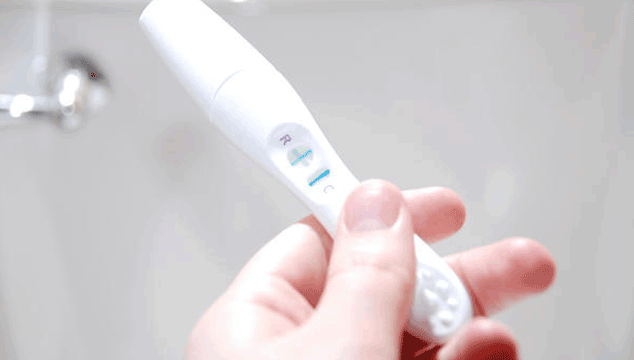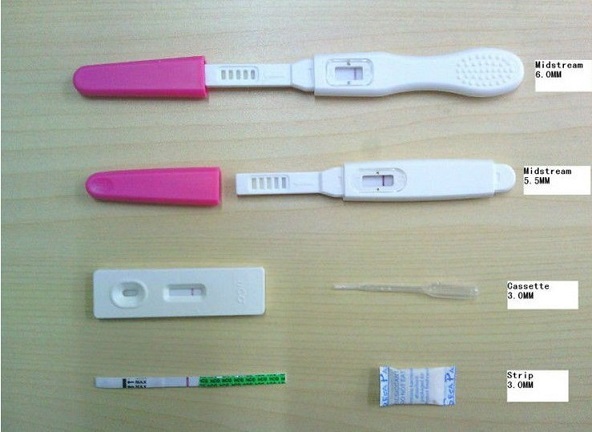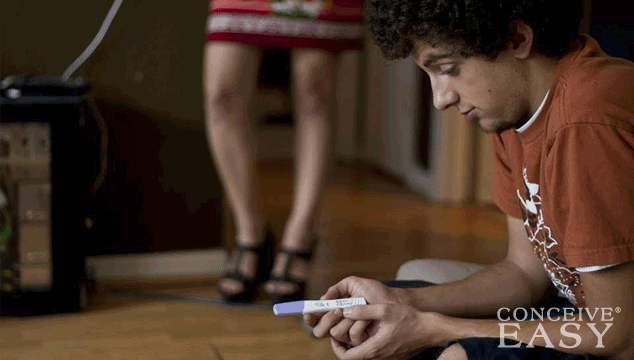![]() The information provided by our expert should not constitute a diagnosis of your condition. Always consult a medical practitioner or healthcare provider for a formal diagnosis. By making use of this content, you agree that ConceiveEasy and the expert assume no liability.
The information provided by our expert should not constitute a diagnosis of your condition. Always consult a medical practitioner or healthcare provider for a formal diagnosis. By making use of this content, you agree that ConceiveEasy and the expert assume no liability.
When it comes to getting pregnant, a pretty important thing to know would probably be how to accurately and correctly read a pregnancy test. Many women struggle with different aspects of pregnancy tests, including which ones to take, when to take them, how to read their results, and how to use them correctly. Claim Your 20 Free Pregnancy Tests – Click Here
Not knowing exactly what to do with a pregnancy test, or using one incorrectly, can actually result in invalid results, or things such as false negatives. This is why it is so important to know all of the different information regarding home pregnancy tests, so that when it is time to use one, women will be ready and will know exactly what to do.

While this might sound like a pretty silly question, it’s actually really important to understand how home pregnancy tests work in order for women to achieve accurate results when it comes to using them.
The first thing to know about at-home pregnancy tests is what they are actually testing FOR.

At-home pregnancy tests are designed to test for rising levels of Human Chorionic Gonadotropin, which is also much more commonly known as hCG. HCG is a hormone in the female body that is secreted by the placenta. HCG levels start to rise shortly after implantation, as the placenta begins to develop. The only time that hCG is present in the human body is from the growing placenta, so this makes it a fantastic and reliable marker for detection of pregnancy.
After fertilization, the embryo will implant in the uterine wall and the placenta will start to grow. This usually happens around a week or so after fertilization occurs, however, at this point, hCG levels will definitely not be high enough to be detected in a home pregnancy tests. The good news is, once a woman becomes pregnant and the placenta begins to form and develop, hCG levels will rise rapidly, and will actually double every couple of days or so.
This is why, as you may know, the longer you wait to take a pregnancy test, the more accurate (and darker) the results will be.
The higher the levels of hCG in the body, the easier it will be for a home pregnancy test to pick up.

There are many different types of home pregnancy tests. It is also important to note that there is also a pregnancy test that is used by testing the blood for the hCG hormone, but obviously, this test can only be done at a doctor’s office and not at home.
However, blood tests can detect pregnancy much sooner than at-home urine tests, and can actually detect pregnancy around a week or so after ovulation. So if you are on expensive fertility treatments, your doctor might choose this option to check for success that cycle or not.
As far as at-home pregnancy tests go, there are mainly two different types of tests. The two types of tests are midstream tests and test strips.

Midstream pregnancy tests are actually exactly what they sound like. To use these tests, you simply hold the test strip in the middle of the urine stream. Every test will have different instructions regarding the exact timing of the test. For example, some tests recommend holding the test strip in the urine stream for 3 seconds, some say 5 seconds, and some may say even longer. This is why it is very important to pay close attention to the instructions of the particular test that you are taking.
Usually, users will be instructed to lay the test flat and wait a certain amount of time before reading the results. Usually this amount of time varies from 3 to 5 to even 10 minutes. Then the instructions will explain how to read the test results. We will cover more on how to read the instructions later in this article.

Test strip pregnancy tests work in a similar way to midstream tests, but they do have a few differences. Instead of holding the test strip in the middle of the urine stream, test strip tests involve collecting the urine in a cup or other container, and then dipping the test strip into the collection container. Some test strips test will actually have the user collect the urine in the container, and then use a dropper to drop the urine onto a different test strip.
Other than the way that the urine is collected, test strip pregnancy tests and midstream pregnancy tests are very similar. There is the waiting time after collecting the urine and then the test instructions will explain how to read the results.


There are so many different at-home pregnancy tests on the market today that it can be very difficult to know how to read the results for each individual test. That’s why reading the instructions that come with the particular test that each woman is using is of the utmost importance.
Just because a woman has taken an at home pregnancy test before does not mean that she should just assume that she knows how to take every at home pregnancy test.
They can be so different and can vary so widely from test to test, it’s imperative that women pay close attention so that they can receive accurate results.
Each and every home pregnancy test should have a “test strip” or a “control band” that will indicate whether or not the test is actually working. It’s so important that women pay attention to the control band. If the control band does not show a line, or shows a faint or “barely there” line, this can indicate that the test is actually not working and should be discarded. It’s also important that women check the expiration date of the test that they are using because an expired test will most definitely give an inaccurate result.


As far as pregnancy tests go, any sort of line in the “results window” usually indicates a positive result. Digital pregnancy tests are, of course, easy to read, since they will say “pregnant,” “not pregnant,” “positive,” or “negative.”
However, with tests that use lines or plus signs to indicate pregnancy, any sort of line should be considered a positive result, even if the line is faint.
This is because the only thing that should produce a positive result on a pregnancy test is the presence of hCG in the body. Sometimes, if a woman is very early on in her pregnancy, she will get a positive result or line on an at-home test, but the line might be very faint. This is usually due to the fact that her body has not had enough time to produce high levels of hCG.
There are very rare occasions that a woman might receive a false positive on a pregnancy test. This is usually due to a reaction to a certain medication in a woman’s body. However, in some cases, there can be blood or protein in a woman’s urine that can portray a false positive pregnancy test. This, however, is very rare.
Usually and for the most part, if a woman receives a positive result on a home pregnancy test, she is almost always pregnant. It is very rare for a woman to receive a false positive on a pregnancy test, since a pregnancy test will only look for and pick up levels of hCG in a woman’s urine.
And something of interest, if you are pregnant with twins, chances are that your pregnancy ‘test’ line will grow darker quicker, due to the multiplying of hCG quicker in your body.

Reading negative results on a home pregnancy test can be much trickier than reading positive results on a home pregnancy test. That is because, for the most part, a home pregnancy test will only pick up a positive result if there is hCG present in the body. However, reading negative results can sort of be harder.

But she may want to be pregnant so badly, that she may trick herself into seeing a line that’s not there.
Most of the time, if a woman receives a negative result on a home pregnancy test, she is probably not pregnant. Home pregnancy tests today are very accurate when they are used correctly, and can usually be trusted if all of the instructions are used correctly. However, there are some reasons that a woman might get a false negative result on a home pregnancy test.
For example, if a woman is actually pregnant, but takes a home pregnancy test too early on, before her body has had time to build up levels of hCG, she might possibly receive a negative result. This is because different pregnancy tests have different levels of sensitivity, and some tests can detect a pregnancy more early on than others.
However, if the level of hCG in the body isn’t strong enough to be detected just yet ,a woman might receive a negative result although she really is pregnant. If this occurs, or is suspected, the best advice is for a woman to wait a few days and test again.
I know easier said that done when you are actively trying to conceive… waiting!
This way, the body will have more time to build up levels of hCG in the body in order to easily indicate if a woman is pregnant or not.
Other times, a woman’s urine might be too diluted to get an accurate result for a home pregnancy test. This is why it is important for a woman to use her first morning urine to take a home pregnancy test, since it is the most “potent” urine of the day and hasn’t had time to get diluted by drinks or foods throughout the day.
Also, if a woman drinks too much water or other beverages throughout the day and then takes an at-home pregnancy test, she could potentially get a negative result. It’s also important to remember that certain medications like antihistamines or sometimes even diuretics can cause a negative result on a home pregnancy test as well. Many times, a negative pregnancy test result can be the result of using the test incorrectly, reading the results incorrectly or using a test that is invalid or expired.

The most important thing to remember regarding using an at-home pregnancy test is that it is imperative that the instructions be followed very carefully. While home pregnancy tests are simple and easy to use, not following the instructions can definitely result in an inaccurate result.
Reading the test results too early
Reading the results too late
Using diluted urine
Testing before the pregnancy test suggests (such as so many days before a missed period or after a missed period)

Dipping a midstream test
Using a dip test as a midstream test
These are all examples of ways that tests can be used inaccurately and can result in invalid results.
You can purchase at-home pregnancy tests almost anywhere, from your local grocery store, even the dollar store, or you can even buy them online and have them shipped directly to your house. The Conceive Easy TTC Kit will give you 20 free pregnancy tests, just for trying their TTC Kit.
Another really important thing to remember is that if a woman takes an at-home pregnancy test and gets a result that she does not think is accurate, it is a good idea to wait a few days or even a week and test again. Sometimes the body just needs more time to build up hormones in order for there to be an accurate test result.
We know it’s agony waiting each day past ovulation to test, but sometimes it’s best to wait!
After taking a second test, if a woman finds that she is still receiving a different result other than what she thinks that she should be seeing, it’s a good idea to see a doctor. Doctors can actually do different types of tests, such as a blood pregnancy test, to determine if a woman is actually pregnant or not.
It’s easy to see that at-home pregnancy tests can sometimes be a little bit confusing, but it’s ok. If you are taking a home pregnancy test, just take your time, read the instructions and make sure that you are testing at the right time during your cycle. If you test too early, you are definitely not going to get an accurate result. Just take your time when you get your pregnancy test, and follow the instructions carefully and you are sure to get the hang of it right away. Good luck and happy testing! Wishing you positive results!











Comments